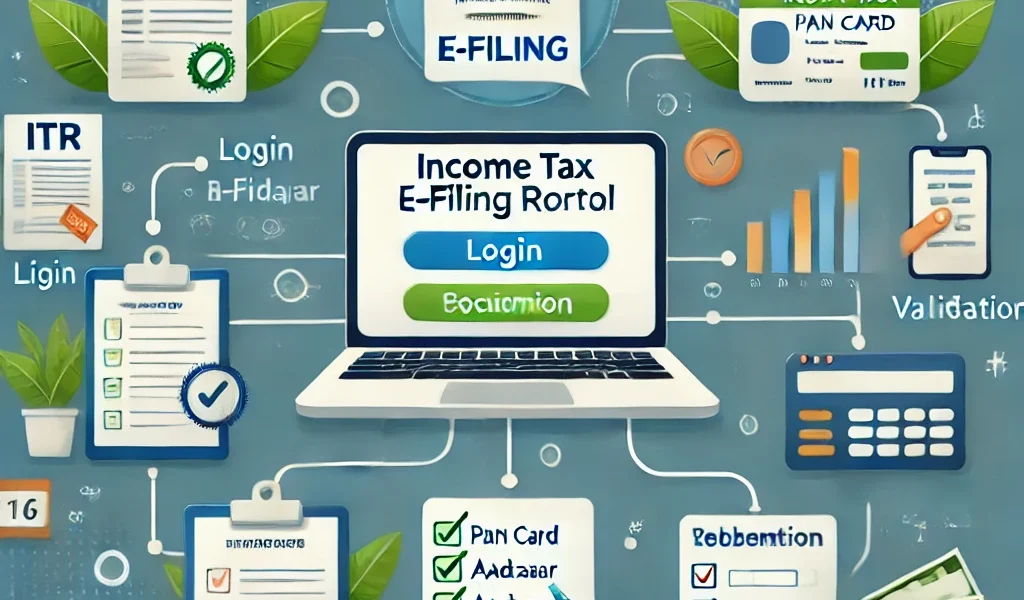Filing Income Tax Returns (ITR) is a legal obligation for individuals and businesses earning income in India. The process ensures tax compliance and allows taxpayers to claim refunds, deductions, and exemptions. However, many people find the process complex and intimidating.
This comprehensive guide will help you understand the importance of filing ITR, the different types of ITR forms, eligibility criteria, and a detailed step-by-step process for filing returns online.
Why Filing ITR is Important
- Legal Compliance: The Income Tax Act mandates eligible individuals and entities to file ITR annually.
- Avoid Penalties: Failure to file ITR on time may attract penalties under Section 234F.
- Claim Refunds: If excess tax has been deducted, filing ITR ensures a refund.
- Loan & Credit Card Approval: Banks require ITR documents as proof of income.
- Visa Processing: Many countries ask for ITR receipts while processing visa applications.
- Loss Carry Forward: Filing ITR allows you to carry forward business and capital losses to future years.
Who Needs to File ITR?
As per the Income Tax Act, individuals and entities falling under the following categories must file an ITR:
- Individuals earning above the basic exemption limit (₹2.5 lakh for individuals below 60 years, ₹3 lakh for senior citizens, ₹5 lakh for super senior citizens).
- Businesses and professionals having taxable income.
- Companies and LLPs, irrespective of profit or loss.
- Individuals with foreign income/assets.
- NRIs with taxable income in India.
- Persons claiming tax refunds.
Types of ITR Forms in India
The Income Tax Department has categorized ITR forms based on the taxpayer’s income source and category:
| ITR Form | Applicability |
|---|---|
| ITR-1 (Sahaj) | Salaried individuals with income up to ₹50 lakh (excluding business income). |
| ITR-2 | Individuals/HUFs with income from capital gains, foreign assets, or high-income sources. |
| ITR-3 | Professionals and business owners (excluding companies). |
| ITR-4 (Sugam) | Presumptive income scheme for small businesses and professionals. |
| ITR-5 | Partnership firms, LLPs, and associations. |
| ITR-6 | Companies (except those claiming exemption under Section 11). |
| ITR-7 | Trusts, NGOs, and political parties claiming exemptions. |
Step-by-Step Guide to Filing ITR Online in India
Step 1: Gather Required Documents
Before filing your ITR, ensure you have the following documents:
- PAN Card
- Aadhaar Card
- Form 16 (for salaried individuals)
- Form 26AS (tax credit statement)
- Bank statements
- Investment proofs (PPF, LIC, ELSS, etc.)
- Home loan and education loan interest certificates
- Capital gains statement (if applicable)
- Business income details (for self-employed individuals)
Step 2: Register/Login on the Income Tax Portal
- Visit the official Income Tax e-Filing portal: https://www.incometax.gov.in
- If you’re a new user, register using your PAN, mobile number, and email.
- If you’re an existing user, log in with your credentials.
Step 3: Select the Appropriate ITR Form
- Based on your income type, choose the correct ITR form as mentioned in the table above.
- If unsure, use the online guided filing option available on the portal.
Step 4: Choose Filing Mode
- Online Mode: Suitable for ITR-1 and ITR-4 (directly fill details on the portal).
- Offline Mode: Download the JSON utility, fill in the details, and upload the file.
Step 5: Fill in the Required Details
- Personal Details: PAN, Aadhaar, address, bank account details.
- Income Details: Salary, rental income, business income, capital gains, etc.
- Deductions & Exemptions: Enter eligible deductions under Sections 80C, 80D, 80G, etc.
- Tax Paid Details: TDS, advance tax, self-assessment tax details from Form 26AS.
- Verification Details: Select verification method (Aadhaar OTP, bank account, or DSC).
Step 6: Validate and Preview Your Return
- Cross-check all entries for accuracy.
- Validate the return and preview before submission.
Step 7: Submit and Verify Your ITR
- Click ‘Submit’ to file your return.
- Choose one of the verification methods:
- E-Verification via Aadhaar OTP (Recommended)
- Net banking verification
- Bank account/Demat account verification
- Sending a signed ITR-V to CPC Bengaluru (if e-verification not done)
Step 8: Track Your ITR Status
- After submission, track your ITR status on the e-filing portal under ‘View Filed Returns’.
- If a refund is applicable, check refund status under ‘Refund/Demand Status’.
Important Deadlines for ITR Filing
| Taxpayer Type | Due Date |
| Individual / HUF / Salaried | July 31 |
| Businesses requiring audit | October 31 |
| Companies | October 31 |
| Revised Return Filing | December 31 |
Common Mistakes to Avoid
- Selecting the Wrong ITR Form: Filing an incorrect form may lead to rejection.
- Incorrect Personal Information: PAN, Aadhaar, and bank details must match official records.
- Not Reporting All Income Sources: Even tax-exempt income must be reported.
- Failing to Verify ITR: ITR is incomplete unless verified.
- Miscalculating Deductions: Ensure all claimed deductions are backed by valid proofs.
- Ignoring Form 26AS: Mismatch in TDS details may result in tax notices.
Conclusion
Filing an Income Tax Return (ITR) in India is a crucial financial responsibility that ensures compliance with tax laws and offers various benefits such as refunds, loan approvals, and tax planning opportunities. With the government’s digitized filing system, the process has become easier and more accessible.
By following this step-by-step guide, taxpayers can ensure smooth and accurate filing while avoiding legal complications. If you have complex income structures or doubts, consulting a tax professional is always advisable to stay compliant with India’s tax laws.




